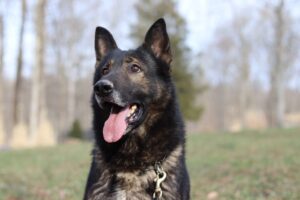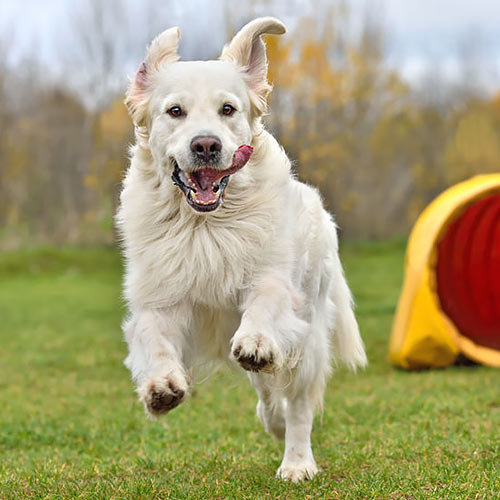The history of the German Shepherd is the most detailed and documented breed in the world. It will be impossible to include all of that information is this one blog article. However, we’ll look at some of the highlights.
The breed originated in the mind of Captain Max Emil Frederick von Stephanitz, a German cavalry officer and a student at Berlin Veterinary College. He began his quest to create the “perfect shepherd dog” in the late 1800s. It took a while to locate sound foundation stock that met his criteria – both physically and temperamentally. He would spend the next 40 years breeding and honing his new breed. He made mistakes along the way but diligently sought to improve any weaknesses that appeared.
The German Shepherd literally began as a herding dog. Stephanitz and his group of enthusiasts wanted a “shepherd dog” that possessed the qualities needed for herding sheep, such as intelligence, durability, speed, strength, agility, and a keen sense of smell. Stephanitz visualized a multi-purpose dog who could be a defender and protector yet still lie down and play with the children at the end of the day. The appearance of the dog was an afterthought. The most important criteria for this new breed was his ability to work. Stephanitz would later write, “Utility is the true criterion of beauty.”
Stephanitz finally found the ideal dog at a show in 1899. He named the dog Horand von Grafrath. Horand was medium-sized dog who not only possessed the physical qualities Stephanitz was looking for but also possessed a strong mental soundness. Horand is the main ancestor of the modern GSD.
Some people wonder why the breed is called a German Shepherd Dog and not just a German Shepherd. “German Shepherd Dog” is the direct translation of Deutsche Schäferhund. Furthermore, a German shepherd only has two legs whereas a German Shepherd Dog has four legs ????
Stephanitz and his newly-founded club, the Verein für Deutsche Schäferhunde (the SV or, Society for the German Shepherd Dog) created a breed standard that would reflect the ideals of the breed, both physically and mentally.
To create any standardized breed, intense inbreeding must take place. The GSD was no exception. The result of inbreeding is a more typical structure where the dogs begin to look the same in body type. But inbreeding also caused problems, as it always does, such as nervous temperament, weak ears, cow hocks, over-sized dogs, etc. Some early dogs were bred that had and passed on temperament flaws, such as aggression and nervousness. Across the years, serious breeders sought to reduce these problems, with varied success (we’ll save that for another article in the future). In fact, today, a good German Shepherd Dog is all about the bloodline behind it!
Once the breed got a foothold in Germany, it’s popularity grew throughout Europe and eventually across the world. One setback in Germany was that railroads hauled sheep and herding dogs were not as needed as before. Stephanitz feared for his new breed. He then began to promote his “shepherd dog” as a police dog. The qualities of a herding dog are much the same as needed for the police dog: durability, agility, keen sense of smell, solid temperament all play a vital role in both careers. The GSD quickly earned the role as a police dog. In fact, jumping ahead several decades, the German Shepherd in the US was more popularly known as a German police dog.
Stephanitz developed a set of tests to determine a dog’s worthiness for breeding and police work. It consisted of phases in obedience, tracking, and protection work. This was the forerunner of the modern IGP (Schutzhund) trials.
The GSD did not gain much attention in the US until after WW1 and another surge again after WW2, as American soldiers returned home to tell stories (sometimes exaggerated) about the feats of these amazing dogs. It is generally believed that there were over 40,000 German Shepherd dogs “enlisted” in the German army during WW1, many of those working on the front lines. The breed did suffer in the US during these wars due to anti-German sentiments and went through several name changes and registration quirks.
However, these world wars also hindered the proliferation of the breed. Dogs were killed, kennels were bombed, and Germans – in retreat – destroyed anything of value to the Allies, including dogs and kennels. This and the lack of food as well as a distemper outbreak, threatened the breed with extinction during/after WW2. Scrupulous breeders and enthusiasts of the breed were able (with much effort) to find solid breeding specimens after the war which enabled the breed to again (after several years of agonizing effort) flourish.
As is normal for any breed, popularity did not help the GSD as a breed. Dishonorable German Shepherd breeders sprouted puppy factories left and right just to make a few quick bucks. Of course, this negatively affected the quality of the pups. In the US, it can be seen that the breed has never fully recovered from this unscrupulous breeding. In fact, if one in the US wants a good, solid GSD, he most always has to look to proven European working lines. The weak, shy, nervous, aggressive GSD – which many Americans think are normal – is not at all normal for the breed! This “new normalcy” has led some to look to other breeds for family companions, protectors, and police dogs. This is a shame because true GSDs still exist and are accessible from conscientious, educated breeders.
The German Shepherd Dog has gone through many changes across the years. Some bloodlines have pursued the show ring, with sloping backs, roach backs, a “flying trot,” over-sized dogs, and more. These purposeful changes have affected the breeds structure, his temperament, and his ability to work – most often hindering the breed.
A historical look at the breed wouldn’t be complete without mentioning genetic diversity. It is a concern among modern GSD breeders/enthusiasts. The breed has been so bred and abused across the years that many breeders have created a genetic bottleneck where health/temperament problems are known and recognized yet still proliferated. GSDs that do not have the genetic bottleneck problem (again, it’s all about bloodline), have fewer health problems and much less temperament problems.
In case you are wondering, our breeding program here strives to breed animals that do not have genetic bottlenecks, therefore producing a better dog – physically and temperamentally. In fact, most of our puppies have a 0% inbreeding coefficient (compare this to the common number of 40% in the US). Is this an advertisement? Maybe. But we’re just trying to convey the fact that genetic diversity in the GSD can be accomplished if one will make the (great) effort.
In spite of the many issues the modern GSD has (other breeds have them too; it’s just beyond the scope of this article to talk about other breeds), it still ranks very high in registrations across the world. GSDs are being sought as police dogs, home protectors, military dogs, family companions, and security dogs.
Need a good German Shepherd Dog or puppy? Contact us.


